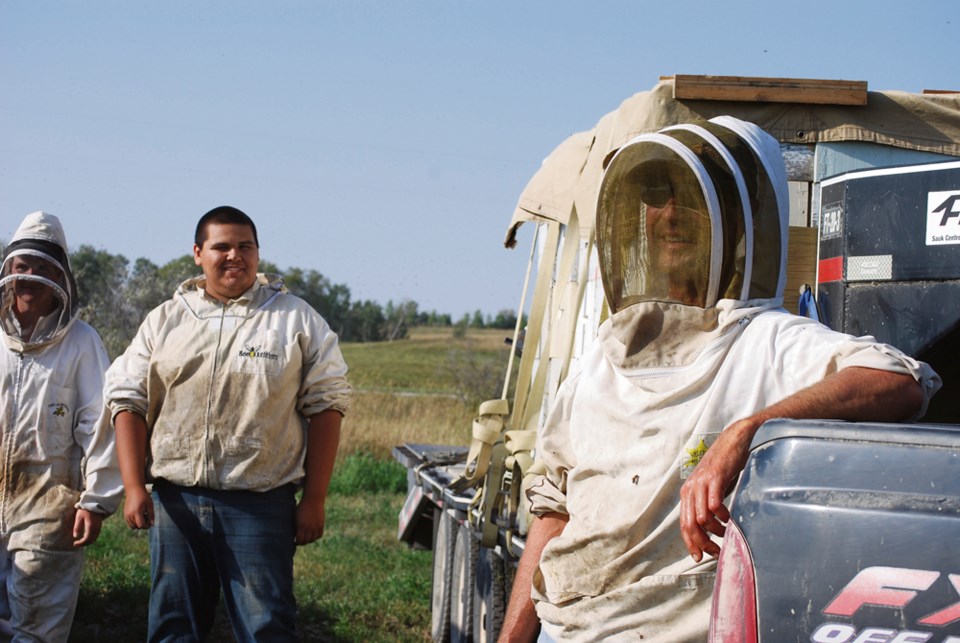Producing honey is a way of life for a family from Oak Lake. Patrick and Melina Cox have been in the honey business for about 15 years.
“I grew up in beekeeping and took a break for 10 years, then got back into it,” says Patrick.
He is the fourth generation to keep bees. He also has a brother and an uncle or two in the business as well.
Their 18-year-old son Jesse is working as part of the field crew; daughter Mikayla (15 years), Timothy (12 years) and Jadon (8 years) also help out with honey extraction and feeding the bees.
Cox says that from the early 1900s the family has operated an apiary; Patrick’s great-grandfather, his grandfather and then his parents, Murray and Peggy Cox kept bees.
“My grandmother had brothers that were into beekeeping as well.”
Building the business
“This is a building year for us. We’ve increased our numbers by about 200 hives this year.”
So, it's a little smaller harvest than last year.
But Cox is not worried about the quality.
“Most of our honey is made from canola, clover and alfalfa. That provides a premium honey. Sometimes when you get into a year like this, since we haven’t had a frost at all, we can start getting a little bit of wildflower honey.
“That makes a more colourful honey. Most consumers in Canada prefer the lighter coloured honey, but probably the more colourful honey is even better for you, because there’s more local pollens in it as well.”
Pollen can be up to 35 percent protein, and contains vitamins, enzymes and pigments. It is one of the most nutritious substances in nature.
Competing against fake honey
While the crop is smaller than last year, the price is better than some years when returns didn’t meet the cost of production for Canada’s bee farmers.
Canadian producers are competing with Argentinian and Chinese imported honey. Cox says the cheaper Chinese product is not necessarily 100 percent bee product.
“It’s really hurting the Canadian honey – the Chinese honey. What they’re doing is making fake honey out of rice syrup and shipping it over and calling it honey.”
For consumers, Cox says, “You have to watch. [Some brands] mix Chinese and Argentinean honey with Canadian honey and still call it Canadian honey.”
His honey goes to a Winnipeg company, a cooperative of Canadian beekeepers who produce, pack and distribute their own honey.
“It’s on all your store shelves as BeeMaid Honey,” a product that he says is 100 percent Canadian honey.
Wholesome product
Honey is more than a sweet treat. The beekeeper explains, “It can be used as fuel, it doesn’t just turn into fat like the other sugars do. There’s more natural enzymes in it and pollens as well.”
Pasteurization (heat) can damage the enzymes and some consumers choose unpasteurized honey for this reason.
“The biggest thing, honey is an antibiotic. It doesn’t support the growth of bacteria. You can use it for wounds.
“If it’s properly cured it will last for centuries,” he says.
Challenges
The long winter was a challenge for beekeepers, but for his hives in the wintering shed, it was the temperature swings that were difficult to manage.
“We have to actually ventilate the shed, to keep the bees cool because they heat the shed for us. We have to bring in fans and fresh air to keep them cooled down, even in 30 below.
“What affected our bees this winter was cold weather and then the odd warm day.”
The warm days triggered bee activity, and the bees consumed much of their food supply, the sugar syrup, by spring.
Early in the season, dandelions and other early wild flowers provide important natural forage.
“Spring is always a bit of a challenge. We have to feed them as well and give them a protein supplement.
“The willows… poplars, maple, everything that starts bursting open in the spring, the bees make use of. Those pollens provide protein for the bees.”
Bees prefer summer highs up to 30 degrees. Recent very hot, dry weather cut into the honey crop as the plant nectar dried up.
Keeping royalty
Aug. 23, Patrick Cox and his crew were picking up honey from a Lenore location, and monitoring the colony.
“We were just looking to see if there was a queen out on the ground.”
The queen is segregated to a lower part of the hive with special “excluder screens” which are too fine for her to pass through but let worker bees come and go.
But sometimes the queen escapes and that’s a problem.
“Without the queen, the colony is doomed. They have to have a queen. Every colony only has one queen. Without her they can’t raise any new workers or field force without a queen.”
The bees on the outside of the hive were fanning (rapid wing movement), all the while emitting pheromones. If the queen is outside, she will be drawn to the pheromones and follow workers back into the hive.
The bees in the fall will survive the winter, but early in the spring they die; new bees are hatched to take over the hive.
Spring-hatched bees wear themselves out working hard.
“They’ll last some times as short as seven or eight weeks. Then, in the fall you get a new batch of winter bees. Their physiology is actually different.”
Winter bees have more fat and are designed to survive the long cold spell.




